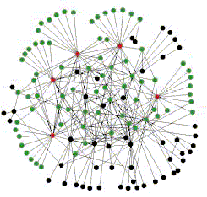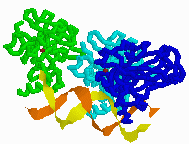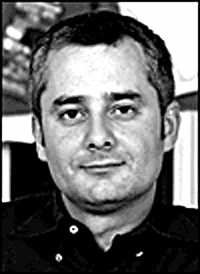

 Contemporary robots travel on the Web and create maps like this.
|
Think Networks:
By Roy Christopher
|
 |
|
A scale-free network of 130 nodes generated by the scale-free model. The five biggest nodes are shown in red, and they are in contact with 60% of nodes (green). (from http://www.nd.edu/~networks) |
Your book seems to explain away the role of chaos in the development of complex networks. Do you think the new discoveries in the behavior of scale-free networks will replace chaos theory as a way to understand large, seemingly chaotic systems?
Chaos is talking about the interactions between a few agents, showing that even simple systems can behave in a rather complicated manner. Network theory does the opposite -- it tells us that rather complex systems follow simple rules and laws. Network theory has allowed us to understand the architecture of complexity, a completely neglected area until recently. As networks are pervasive, we simply cannot ignore this message.
Mark Granovetter's idea of the 'strength of weak ties' has intrigued me since reading Malcolm Gladwell's The Tipping Point. It seems such a simple idea that explains so much and to which I hadn't really given much thought before. Do you see this idea as one of the unsung traits of the behavior of networks?
Granovetter's wonderful and rather influential insight, that weak ties play a key role in our social network, is still valid. Network theory has shown us, however, that there is a brand new world out there beyond the weak ties, that without data Granovetter could not even imagine addressing. The role of the hubs could not be appreciated until a few years ago, when we finally got real data on complex networks. Yet, following up on Granovetter's insight is still a dream for us-- while we have detailed topologies describing everything from the www to the collaboration networks, the strength of the ties is most of the cases is not available. This is one of the future directions for network research.
Tell me about your interest in 'parasitic computing.' Where do you see this area going in the future?
Parasitic computing was a proof of a concept for us -- to show that one could turn the whole Internet into a computer, distribute a large computation on thousands of unsuspecting computers. For this we designed a way to turn anybody's computer into a slave for us, making them to unwillingly perform computation on our behalf. Do not worry -- we did not used your computers. We just demonstrated on several computers that this is possible. The future of parasitic computing could lead us in many directions. It need to be made efficient, and in this case it could turn into a mainstream distributed computation tool. For that to happen, we need to address the technical, ethical, and legal aspects of the process, which I believe that it could be worked out. It could also turn into an underground method for computation, where people will quietly use it. We published our results so that people are aware of the possibility, and we will have safeguards against it before too late. Finally, parasitic computing could simply allow us to think outside of the box. My collaborator on the project, Vince Freeh, is doing just that, and he has some wonderful ideas on the future of parasitic computing, that will surprise many, I am sure, once he is ready to talk about them.

|
| p53, a tumor suppressor molecule, one of the hubs of the cell's regulatory network. |
Is there anything else on which you're working that you'd like to mention here?
My interest has lately turned towards biology. I see cell biology the
area where network thinking would have a biggest impact in the near
future. With the genome project finished, we have all the pieces, and we
need to understand how the cell works as a whole. It is a wonderful
challenge, with sure impact on everything from cancer research to drug
development.

